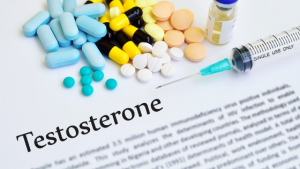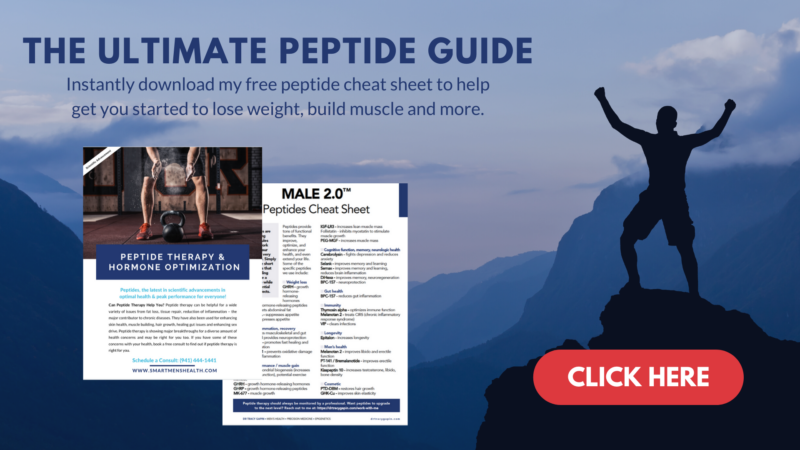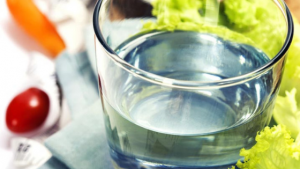
If you’re suffering from symptoms of low T, you’ll try anything to overcome low testosterone and get back to feeling vibrant, young, and sexy once again. So you visit your doctor, and your doctor mentions testosterone replacement therapy.
But what is TRT? What are the risks of testosterone replacement therapy for men looking to raise their T levels and revitalize their energetic wellness?
What is low testosterone?
Low testosterone levels can occur with age or as a cause of poor diet, stress, hormonal imbalance, and other irregularities in the body. “Low testosterone” is usually defined as a testosterone level below 300 ng/dL.
Some doctors will also look at the free-floating levels of testosterone, which may be a better indicator of the severity of symptoms for a man suffering from low T. Free-floating testosterone is the testosterone hanging out in the bloodstream that’s not currently being used for another hormonal process.

Low T can lead to a number of severe symptoms that drastically impact quality of life:
- Lowered libido/sex drive
- Reduced performance in bed
- Increased anxiety and depression
- Brain fog and difficulty concentrating
- Diminished motivation and energy
- Disturbed or not restful sleep
- Increased body fat
- Muscle loss
- Fatigue
- Swollen or tender breasts
- Hot flashes
- Fewer erections and/or difficulty sustaining erections
Low T creates a general sense of un-wellness that is often so severe it impacts the man’s ability to have a “normal” life. Moreover, low T is linked to a number of serious health issues including diabetes, obesity, metabolic syndrome, osteoporosis, cardiovascular disease, and ED. There is even a link between low testosterone and shorter life expectancy.
The only way to overcome low testosterone symptoms is to hit it at the source: raise your testosterone levels. There are two ways you can boost your T levels: artificial therapies and natural lifestyle changes. This article is talking about the artificial way. If you’d like natural ways, click here for a great article: https://fitnessvolt.com/boost-testosterone-naturally/

Want our Peptide Guide? Email us at info@drtracygapin.com
What is Testosterone Replacement Therapy (TRT)?
TRT is an artificial form of testosterone that is applied or injected into the body to raise testosterone levels. There are a number of forms of testosterone replacement therapy: gels, injections, skin patches, mouth patches, and implants.
Most experts won’t administer oral testosterone because it can have negative effects on the liver. The other methods bypass the liver and deliver testosterone directly into the bloodstream to quickly raise free-floating T level.
Note that TRT is not the same thing as steroids. Although some athletes and gym goers will inappropriately use testosterone injections and implants to “boost their gains,” TRT isn’t worthy of that same “roid rage” reputation. When administered safely by a professional, TRT will not have these same hulk-like effects.

What are the benefits of Testosterone Replacement Therapy?
For some men, TRT is the right solution. For those men with severely low T levels, TRT can help bring them to a normal level quickly and effectively.
Moreover, studies have shown some significant improvements with TRT, including:
- Increased bone strength and density
- Improved muscle strength
- Fiercer sexual function and libido
- Enhanced endurance and ability to gain muscle
- Heightened mood and energy
- Improved hemoglobin levels in participants with anemia
- Potential boost in cognitive function
What are the risks of Testosterone Replacement Therapy?
TRT is used to pull testosterone levels back to a healthy range. However, TRT has two serious restrictions.
The first is that TRT is artificial. When applying or taking this type of testosterone, you’re introducing unnatural hormones into the body. The body usually responds negatively to “foreign” entities, even though this artificial testosterone is constructed to mimic natural testosterone.
The second key restriction is that testosterone replacement therapy only works in the short term. It will alleviate your symptoms for a given time period… but then it wears off. You then have to go back for another treatment or go through another application.
Aside from these restrictions, TRT also has some other severe risks that are important to consider before beginning a therapy process.
1. Infertility
When your body doesn’t have enough free-floating testosterone (low T), your pituitary gland sends out a hormone called luteinizing hormone (LH). This LH signals the testicles to start producing more testosterone naturally in order to restore your levels. The pituitary gland also sends out a hormone called follicle stimulating hormone (FSH), which signals sperm production. When you have low T, it could be because your pituitary gland has stopped sending out these signals as it used to.
When you start introducing artificial testosterone through TRT, the pituitary gland doesn’t detect that the testosterone levels are naturally low. It says, “Okay, that’s enough,” so it stops sending out the LH and FSH at all. This, in essence, tells your testicles to stop producing testosterone and sperm—which are the two primary functions of the prostate.
In essence, one of the greatest risks of testosterone replacement therapy is that it tells your body to stop naturally creating sperm and testosterone.
When your testicles aren’t working, they start to shrink. In the long term, this can severely hurt your fertility. Your testicles will shrink and stop producing sperm, which will make it harder for you to get your partner pregnant.
Moreover, it tells your body to stop producing testosterone. This means that your body has “forgotten” how to naturally produce testosterone on its own, so you become dependent on TRT.
One of the risks of testosterone replacement therapy is the very thing that keeps TRT in business… once you’re on TRT, you’re on it for life.
Worse yet, this testicle shrinkage and infertility is often irreversible.

2. Breast Enlargement
Even with the natural production of testosterone, some T is converted into the hormone estradiol. Estradiol is a form of estrogen that can stimulate breast tissue to grow. When you add more testosterone quickly, as with TRT, your body senses an influx of T. It will the convert a higher percentage of the free testosterone to estradiol. This estradiol can cause gynecomastia, which is a fancy term for “man boobs.” It’s also important to note that gynecomastia is linked to a 10x higher risk for breast cancer in men.
If you spur testosterone production naturally, though, you have a slower release of testosterone into the bloodstream. The body won’t detect high levels of T to convert, so a smaller percentage of the testosterone will be converted to estradiol.
3. Swelling
TRT can make your body hang on to excess fluid. For many men. this can cause swelling in the feet and ankles. It’s similar to how pregnant women’s feet swell due to hormonal changes in their bodies!
4. Acne
Artificial testosterone introduces new hormones into the system, which can change the type of skin you have. You might go from a dry face to an oily one, a clear complexion to one filled with cystic acne. How your body responds to these foreign hormones can be unpredictable.
5. Spreading
One of the major concerns with at-home TRT is the proximity to women and children. For example, a man uses testosterone gel, applied to his arm once per day. After application, he bumps against his wife while reaching for the keys, and some of the gel wipes off on her without their knowledge. He then reaches down and picks up his eight-year-old son to give him a hug goodbye. He pets the family dog and leaves the house.
This has now spread testosterone to other members of the family. For women, this can throw off their estrogen balance and cause concerns with fertility, hair growth, and even ineffective birth control. Spreading testosterone to children frequently can even cause children to go through premature puberty. Testosterone spread to pets can actually make them more aggressive and volatile.
If you don’t properly wash your hands, dispose of the gel, and protect the application area every single time, you could do damage to your loved ones.

6. Other side effects
Other side effects include sleep apnea, moodiness, pain, soreness, rash, itching, and allergic reaction. Read the Therapeutics and Clinical Risk Management review for the benefits and risks of testosterone replacement therapy to learn about more side effects.
7. Cardiovascular problems
There has been debate whether or not TRT is linked to cardiovascular problems. Early studies found that testosterone therapy was linked to coronary artery plaque buildup, but recent studies have overwhelmingly disproven these results. Most reviews conclude that there is “no compelling evidence to indicate that T therapy increases cardiovascular risk.”
However, there are still some potential clotting concerns with TRT. Testosterone therapy increases hematocrit, which is the percentage of red blood cells in the bloodstream. If this percentage gets too high, the blood thickens and can start causing clots. This should not be a concern when a doctor safely administers TRT in a regulated way.
Is prostate cancer a risk of Testosterone Replacement Therapy?
Early studies demonstrated a positive association between TRT and long-term growth of prostate cancer. However, experts are beginning to realize the relationship is much more complex than that. There are two key theories with regards to the link between TRT and prostate cancer.
Some believe the saturation theory, which says that the prostate becomes more sensitive to androgens when at lower testosterone levels. Then, when TRT introduces artificial androgens into the system—which already has low testosterone— it stimulates the prostate cells to grow more rapidly.
The second hypothesis is the dependence theory. This says that the duration of exposure to androgen levels is the primary driver for risk of cancer. Basically, the longer you introduce artificial testosterone androgens into the body, the more likely you’ll increase your risk for mutated cells.
However, neither theory has been proven or disproven. Rather, it’s been concluded that TRT does not necessarily cause prostate cancer, but it may worsen it. Most doctors will not give TRT to anyone with active prostate cancer, as it can progress the disease at a faster rate. When administering TRT to patients with a low-risk for prostate cancer, most doctors will check the patient’s PSA levels yearly.
The reason TRT may worsen prostate cancer? Because artificial testosterone converts to estradiol, which is a form of estrogen. And estrogen may be linked to prostate cancer! Learn more about the link between testosterone, estrogen, and prostate cancer here.
Although TRT does not necessarily cause prostate cancer, it still has some effect on the prostate. Testosterone replacement therapy has been linked to BPH and testicle shrinkage, as discussed above under “infertility.”
What is the alternative to TRT?
I believe that the natural solution is always the best solution first and foremost. It is possible to naturally increase your testosterone levels in the long-term without damaging your body.
Learn more about natural, effective methods to boost testosterone here:
Bottom line
TRT can have some benefits to improving quality of life right away—but ultimately, the long-term risks are not worth the short-term reward. TRT stops the natural production of testosterone and sperm, making you dependent upon TRT if you want to live a normal and healthy life. But there’s no need to worry about the serious, long-term risks of testosterone replacement therapy. Natural lifestyle changes can and will stimulate your body’s natural production of testosterone once again.
The best place to start if you want a hormonal optimization or peptide program is by seeing a physician first. Have a doctor draw your blood and evaluate whether you are a candidate for therapy.
Smart Men’s Health with Dr. Tracy Gapin is currently accepting new clients and offers a comprehensive evaluation, blood test and state-of-the-art screening. If you are tired of being tired… or you have tried everything to lose that unwanted weight but nothing seems to be working, our Peptide therapy might be the piece to the puzzle that you are missing. Call us today to schedule your consultation. (941) 444-1441.
Upgrade to Male 2.0™– Schedule a Consult!
You’ll get access to a genetic-based report and analysis, along with a private consultation that will put you on track to your ultimate health.
With the Male 2.0 Method, I test your DNA, interpret the results, and create a customized strategy just for you. This plan is specific to YOUR individual genes and lifestyle. It will improve every area of your life, from your health and professional productivity to your overall longevity and total wellbeing. Male 2.0 gives you the actionable tools you need right now. It reveals what you need to customize and design your future limitless self.
Click here to learn more about the lifelong benefits of a personalized genetics consultation and epigenetic coaching program.
Want more tips to optimize your health? Listen to the latest podcasts. Click HERE
I look forward to working with you to take your health goals to the next level.
COMING SOON TO AMAZON
 In Male 2.0™, Dr. Tracy Gapin has turned everything we once thought we knew about men’s health and performance upside down. The old model of how to be “a man” is broken. A man who works himself to death. A man who tries to NOT get sick but isn’t really healthy either. A man who takes a pill for every ill but is never really cured. That was Male 1.0. Now, imagine being THE MAN ─ owning your performance in the bedroom, the weight room, and the boardroom. Living a fully optimized life. Becoming limitless. This is Male 2.0!
In Male 2.0™, Dr. Tracy Gapin has turned everything we once thought we knew about men’s health and performance upside down. The old model of how to be “a man” is broken. A man who works himself to death. A man who tries to NOT get sick but isn’t really healthy either. A man who takes a pill for every ill but is never really cured. That was Male 1.0. Now, imagine being THE MAN ─ owning your performance in the bedroom, the weight room, and the boardroom. Living a fully optimized life. Becoming limitless. This is Male 2.0!
Tracy Gapin, MD, FACS is a board-certified Urologist, Men’s Health Expert, Author, and Professional Speaker. Using state-of-the-art biometric monitoring, nutrition and lifestyle intervention, Dr. Gapin coaches Fortune 500 executives and evolutionary leaders of business, sports medicine, and high performance. He specializes in cutting-edge precision medicine with an emphasis on Epigenetics, providing men with a personalized path to optimizing health & performance. www.SmartMensHealth.com



































